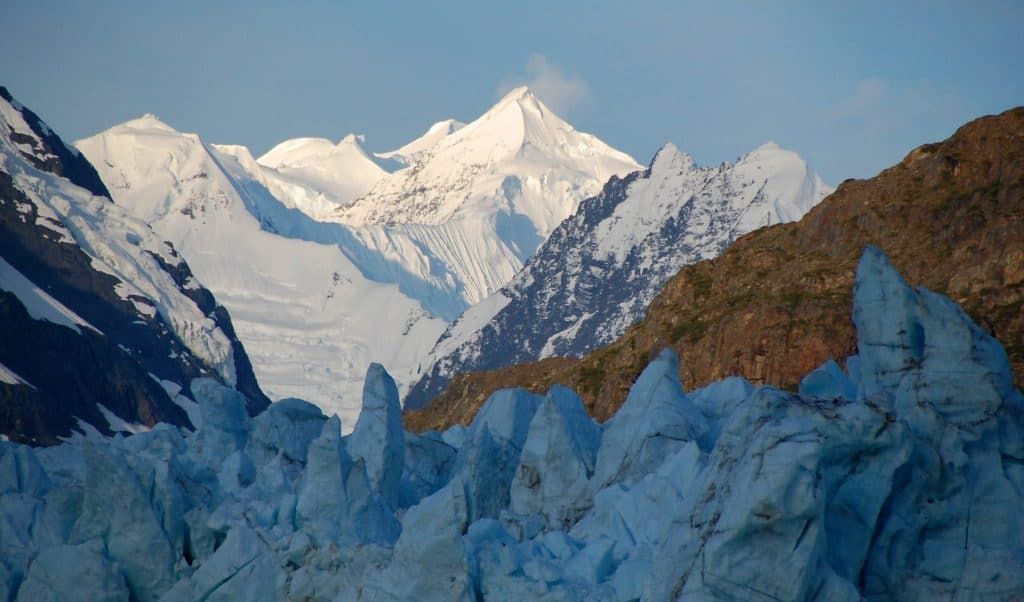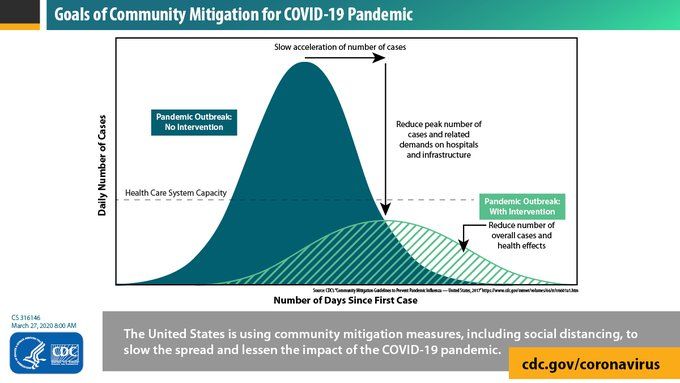Heal the Earth: flatten other curves
By Dawn Stover | April 22, 2020
 The Fairweather Mountains and Margerie Glacier at Glacier Bay National Park in Alaska. Margerie Glacier is one of the few tidewater glaciers in the park that is not receding. Credit: National Park Service
The Fairweather Mountains and Margerie Glacier at Glacier Bay National Park in Alaska. Margerie Glacier is one of the few tidewater glaciers in the park that is not receding. Credit: National Park Service
Around the world, countries and their citizens have been working to “flatten the curve” of the coronavirus pandemic. The idea is to slow the spread of the virus, so that healthcare systems are not overwhelmed by a massive surge of cases. When the number of new cases declines from one day to the next, as seems to be happening in the United States, it’s a sign that the strategy is working.
The coronavirus pandemic is just one curve that needs flattening, though. Life on this planet will not be sustainable for humans over the long term unless its inhabitants make other behavioral changes to ensure that we don’t exceed Earth’s carrying capacity. The pandemic hasn’t just revealed the fragility of the healthcare system; it has also revealed the limits of an economic system focused on consumerism and perpetual growth.
We need to flatten the curves of climate change, overpopulation, and overconsumption. Via COVID-19, perhaps Earth sent us all to our rooms to think about what we’ve done—and how we can fix it.
The climate curve. When I saw the first graphs of COVID-19 cases, they reminded me of how global surface temperature has risen abruptly during the past half-century. As the mercury draws ever closer to 2 degrees Celsius of global warming, climate experts have issued increasingly dire warnings that humanity must reduce its greenhouse gas emissions and bring them down to net zero as quickly as possible. In other words, we must flatten the carbon curve to stabilize the planet’s climate.

That won’t happen overnight, just as COVID-19 case numbers did not come down the instant people began staying home and practicing social distancing. But if COVID-19 has taught us anything, it’s that we can’t wait until disaster is already upon us to begin taking serious action.
It takes more than a subset of responsible individuals to flatten the curve. As with the coronavirus, meaningful climate action requires government action. Only governments have the power to structure taxes, regulations, and subsidies in a way that quickly brings down carbon emissions.
The consumption curve. The equation I = PAT, formulated around the time of the original Earth Day 50 years ago, represents human impact on the environment (the I in the equation) as the product of three factors: population, affluence, and technology. All three of these factors have curves that need attention.
The world population now stands at 7.8 billion and is expected to reach 8 billion by 2023, 9 billion by 2037, and 10 billion by 2056. Although population is now growing at a slower rate than 50 years ago, that curve must get even flatter to reach a stable population.
Population doesn’t tell the whole story of human impact, though. Affluence determines the rate at which individual humans gobble up resources. Collectively, the nations of the world would need 1.75 Earths to sustain our current rate of consumption, the Global Footprint Network calculates. But for everyone to be able to live at the average American’s level of affluence, we would need five Earths’ worth of resources.
If resource consumption continues to overshoot the planet’s ability to regenerate these resources, we will exceed the Earth’s carrying capacity. We can build more ventilators, but not more Earths.
Technology, the third factor, can help reduce human impacts on the environment. For example, increased energy efficiency and renewable energy can help reduce the demand for fossil fuels. So far, though, increased renewable energy has not brought about any reductions in fossil fuel use.
Rebuilding the natural stockpile. The stay-at-home orders and social distancing measures adopted to fight the coronavirus pandemic have also given many people a new appreciation for basic human needs such as food, clean air and water, and open space. Our planet has become increasingly urbanized, and much of our economic growth here in the United States has been concentrated in crowded cities where viruses can easily spread. Even parks and beaches no longer have enough space to safely practice social distancing.
Even as the planet is becoming more urbanized, it is also losing more and more land to development for home building, agriculture, oil and gas extraction, and a multitude of other human activities. Habitat for wildlife has shrunk, making it easier for viruses to “spill over” to humans from other species. The world’s growing food demands are only making this problem worse.
Human health depends on a healthy environment, and for too long we have let that environment deteriorate—like a national security stockpile of life-supporting supplies and equipment that has not been replenished and reinforced. Call it a natural security stockpile.
The doughnut model. In the natural world, population overshoots are self-correcting problems, but a massive die-back of the human species is something that most people would like to avoid. What’s the alternative?
There is no vaccine that can prevent an unhealthy environment, but there are some alternative economic models that could not only help us recover from the pandemic but also heal the Earth. One example is the “doughnut model” proposed by British economist Kate Raworth of Oxford University’s Environmental Change Institute. The idea is that humanity should strive to live between the inner ring of the doughnut—the most basic human needs such as food, water, and healthcare—and an outer ring beyond which human activities damage the health of oceans, the atmosphere, forests, soil, biodiversity, and other ecological systems.
We’ve just seen a massive demonstration of how humans can take collective action to reduce the demands on hospitals and other infrastructure to a level that does not exceed their maximum capacity. Surely we can begin to make other interventions to ensure that we live within our planet’s means.
Together, we make the world safer.
The Bulletin elevates expert voices above the noise. But as an independent nonprofit organization, our operations depend on the support of readers like you. Help us continue to deliver quality journalism that holds leaders accountable. Your support of our work at any level is important. In return, we promise our coverage will be understandable, influential, vigilant, solution-oriented, and fair-minded. Together we can make a difference.
Keywords: COVID-19, Coronavirus, Earth Day
Topics: Biosecurity, Climate Change, Columnists















Thank you, Dawn Stover, for your excellent articles on climate change and healing the Earth. Aloha from Hawaii!